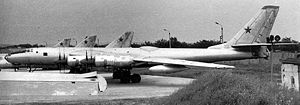Tupolev Tu-119 Video - Picture

|
|
Tupolev Tu-119
Tupolev Tu-119

Picture - The Tu-95LAL test aircraft. The bulge in the middle covers the reactor.
Role: Experimental Nuclear aircraft
Manufacturer: Tupolev Design Bureau
Status: cancelled
Number built: 1
The Tupolev Tu-119 (Tu-95LAL) test plane was a modified Tupolev Tu-95 Soviet bomber aircraft which flew from 1961 to 1965. It was intended to see if a nuclear reactor could be used to power an aircraft. Without the need to refuel, the resulting nuclear aircraft would have greatly extended range compared to conventional designs. The design was analogous to the United States' earlier Convair X-6.
Description
During the cold war the USSR had an experimental nuclear aircraft program, like the USA. On 12 August 1955 the Council of Ministers of the USSR issued a directive ordering bomber-related companies to join forces in researching nuclear aircraft. The design bureaus of Andrei Tupolev and Vladimir Myasishchev became the chief design teams, while N.D. Kuznetsov and A.M. Lyulka, were assigned to develop the engines. They chose to focus on the direct cycle system from the start, testing ramjets, jet engines and even turboprops.
The Tupolev bureau, knowing the complexity of the task assigned to them, estimated that it would be two decades before the program could produce a working prototype. They assumed that the first operational nuclear-assisted airplane could take to the air in the late 1970s or early 1980s. In order to gain experience with the operational problems, they proposed building a flying testbed as soon as possible, mounting a small reactor in a Tupolev Tu-95M to create the Tu-119.
The reactor was fitted in the bomb bay of the aircraft, although it did not fit cleanly and a "bump" was put on top as well. According to some sources, the aircraft had two conventional NK-12 outboard turboprop engines and two experimental NK-14 'dirty' direct cycle jet engines powered by a minimally shielded nuclear reactor in the main fuselage. Between May and August 1961, the Tu-119 completed 34 research flights. Most of these were made with the reactor shut down. The main purpose of the flight phase was examining the effectiveness of the radiation shielding which was one of the main concerns for the engineers. Massive amounts of liquid sodium, beryllium oxide, cadmium, paraffin wax as well as steel plates were used for protection. Some sources claim that the aircraft could stay in the air for around 48 hours, or for as long as the air crew could survive the radiation emitted by the reactor. The results were promising; radiation levels were low enough to consider continuing development. But, as in the US, development never continued past this point. The apparent potential of the Inter-Continental Ballistic Missile made the expensive nuclear aircraft program superfluous, and it was scaled back.
Specifications (Tu-119)
Comparable aircraft
Convair X-6
Bibliography
Gordon, Yefim; Komissarov, Dmitriy and Sergey (2004). OKB Ilyushin: A History of the Design Bureau and its Aircraft. London: Ian Allan. ISBN 1-85780-187-3.
Living Warbirds: The best warbirds DVD series.
Source: WikiPedia